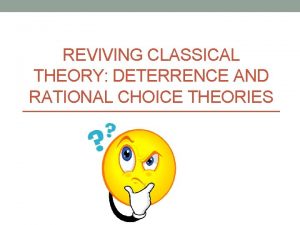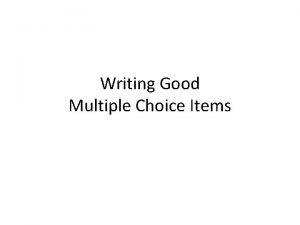Important Review Concepts Dem Multiple Choices Multiple Choice








- Slides: 8

Important Review Concepts Dem Multiple Choices

Multiple Choice Section • Quantitative variables are numerical, but additionally must measure either how many or how much of something there is. • While technically they have units, sometimes the units are not obvious, so if you pretty sure something is quantitative and simply cannot determine units, then you might want to trust your gut. • Categorical (or Qualitative) variables are labels or categories. • This will include all non-numerical data, but also includes numbers which are used as labels.

Multiple Choice Section • Some Important Normal Curve Properties • Unimodal • So predictably uniform or multimodal distributions would not qualify. • Symmetric • So predictably skewed distributions would not qualify. • Appropriately few outliers with most outliers not being too extreme. • Multiple outliers which are 5 or more standard deviations from the mean would definitely keep a distribution from qualifying.

Multiple Choice Section • For Categorical Data: • Bar Chart (Particularly good when making graphs by hand or when using data which must go in order. ) • Pie Chart (This should only be used when there is no overlap between categories. ) • Segmented Bar Chart (This is sometimes easier to make by hand than a pie chart and it is best used when comparing two groups of uneven size. ) • Frequency Table (Used to organized univariate data. ) • Contingency Table (Used to organize bivariate data. )

Multiple Choice Section • For Quantitative Data: • Dot Plot • Advantages: Aesthetics (Looks Pretty, More Artistic Options) • Disadvantages: Takes So Much Time • Lineplot • Advantages: Very Intuitive, Good For Time-Based Trends • Disadvantages: Can Be Misleading When Not Time-Based • Stemplot • Advantages: Preserves Original Data, Good For Side-by-side Comparison of 2 Data Sets • Disadvantages: Takes So Much Time , Not Very Intuitive At All Without Specialized Training

Multiple Choice Section • For Quantitative Data: • Histogram • Advantages: Decent For Comparing 2 Side-By-Side Distributions, Relatively Intuitive • Disadvantages: The Patterns You See Depend On Scale • Boxplot • Advantages: Good For Comparing Multiple Distributions, Modified Boxplots Make Outliers Easier To Process • Disadvantages: Not Very Intuitive At Without Specialized Training

Multiple Choice Section • Weighted Means are used when the various values do not occur with the same frequency. • GPA with different credit hours is an example, true, but there are other situations. • Center of mass is a common sort of calculation in physics classes, for example, that some of you will take in college. • When you have the averages for two groups of different sizes, you also can use a weighted mean. • On #5 of the review, for example, the class sizes form the weights.

Multiple Choice Section • Z-Scores measure the amount by which a value is above or below the mean, but it does this in terms of standard deviations. • The more common way for this to be phrased is that a z-score is “the number of standard deviations that something is above or below the mean”. • It should be noted that if you have more than one group, that you need to be specific as to which group’s mean was used.
 Good choice or bad choice
Good choice or bad choice Chapter 9 making healthy food choices review answers
Chapter 9 making healthy food choices review answers Deterrence and rational choice theory
Deterrence and rational choice theory Rational choice theory key concepts
Rational choice theory key concepts Example of a news story
Example of a news story From most important to least important in writing
From most important to least important in writing Least important to most important
Least important to most important How to write multiple choice questions
How to write multiple choice questions Binary choice items
Binary choice items















